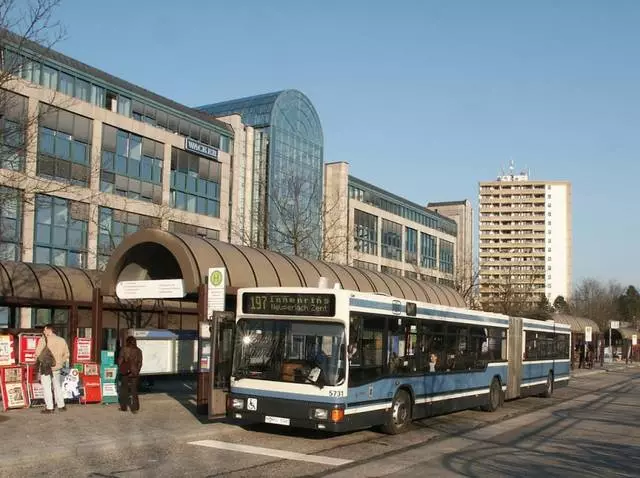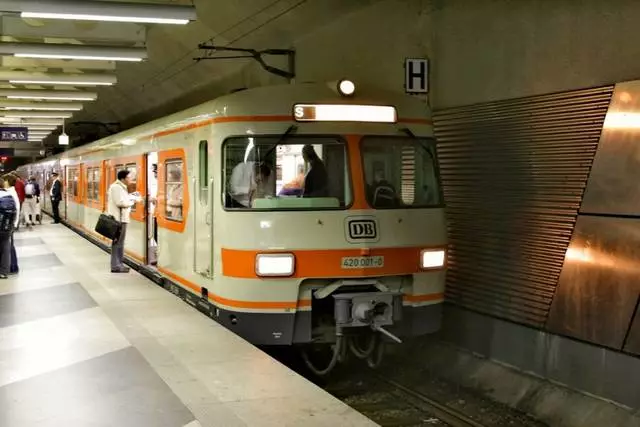In the capital of Bavaria There are no problems with public transport , because The system is developed and perfectly established : There are well-working bus routes, tram lines, Metropolitan U-Bahn and urban electric train S-Bahn. You can reach any distant corner of the city, the accuracy of the transport movement is observed up to minute (Germans, as you know, the people punctual). The delay can, of course, happen - but for some of the row of the extending reason, in order of exception.
When using urban transport in Munich, visitors still some difficulties may arise - namely On the issue of acquiring a suitable ticket . They are in different ways, depending on the zone of action and travel range. In Munich, there are four transport areas: internal - Innerraum, a XXL zone (white and green), an external - Ausserraum (green, yellow and red), as well as the common, called GesaMtNetz. The price of the ticket is calculated depending on the zone of action, and the type of movement is not important. You can ride one zone on any of them, and ticket costs will be the same.
there is Different types of tickets - intended for short distances and cover only one zone, or for long trips, also in the same zone; There are blocks for ten tickets - Streifenkarte; There are still daytime Single-TageSkarte tickets, designed for one passenger, and Partner-TageSkarte - for five; Tickets designed for a week of use by one passenger - Isarcard - Wochenkarte.
Buses
Bus transportation in the city are carried out with the help of three types of transport: Metrobus, Stadtbus and special TaxIbus. The first type of bus is available for eleven lines, the second is fifty-seven. The number of stops in Munich is about nine hundredths, and the total length of routes is 458 km.
Metrobus.
The buses of this species have a two-digit room, they carry out transportation on the lines with fifty-sixties. With the help of such transport, the message has been established between the distant corners of the city, areas with shopping centers and local transport nodes are connected. Interval of movement in the bright time of day - ten minutes, in the evenings he increases to twenty. All buses on such lines - extended, with "harmonic".

Stadbus.
Most of the bus transport in the city is exactly this type. The interval of movement is from ten to twenty minutes at different times of the day. There are various ranges of numbers that are related to different areas:
From the 30th to the 159th, they work on tangential lines, as well as internal and southern; From the 160th to the 169th - serve Western regions of Munich; From 170th to the 179th - works in the northern part of the city;
From the 180th to the 189th works in the northeastern part of Munich; From 190s to 199th - southeast of the Bavarian capital.
The most useful line for those who arrived in Munich in tourist purposes is the 100th, it is called "Museum": This route connects the eastern station with the main station, in the route buses cross the entire city and pass by twenty-four urban museums.
Lines from 101st to 106th and from 112th to 127th - additional respectively for the metro and tram.
Trams
Tram in German - Straßenbahn München, the townspeople themselves call him shorter - tram. It is one of the main ways to move around the city and at the same time - the oldest: the beginning of the operation of the first compositions is dating from 1876th year. Nowadays, the total number of routes is eleven. They start working from 04:30 and finish at 01:30. In general, Munich's tram lines have more fifty stops, and the total length of these lines is seventy-five km. At night, trams also go - such work begins at 01:30, and ends - at 04:30. Number of stops - 113, movement interval - thirty minutes or an hour.

Almost all urban stops in Munich are pavilions for passengers, a schedule of transport movement is indicated. If there are some changes in the chart, passengers communicate over loudspeakers.
Metropolitan.
The main and, probably, the most convenient way to move in this city. Opened the metro in the distant 1971th, this event was timed to the Olympics-72. Nowadays, there are hundreds of stations, the total length of lines is more than a hundred km. Infrastructure - at an excellent level, there is everything for the convenience of passengers, so that we use the metro with all its escalators, travolors and elevators in Munich very conveniently.
The metro branches are denoted by numbers with U1 by U7 and differ in flowers. Trains on branches from U1 to U7 are moving in the central part of the city by the same tunnels and stations. Branch U6 stretches for the city, in Garching.

There are no turnstiles in U-Bahn, tickets are checked at the entrance to the station - controllers work there. On weekdays, the subway opens at about 04:00 and closes at 01:00, it works longer on weekends - until 02:00. The compositions of the peak are moving at an interval of five minutes, the remainder time with a ten-minute break.
Almost all metro stations Munich - underground. There is only one axem on the U5 branch and five ground - on the U6 branch. From 07/02/2011 at all metro stations in Munich, it became possible to use the mobile communications, the exception is only two stations in Garching.
Urban electrician
The city electric train in the capital of Bavaria also discovered in front of the Olympics of the 72nd. She, as well as the Metro, is the main type of urban transport. In total, the length of all routes is 442 km, and the total number of stations is 148. On the lines of the city electric train S-Bahn, eight hundred thousand passengers is transported daily.
In total, there are ten branches: those that are designated with S1 in S7 are serviced, by analogy with the subway lines, the central part of the city, and work on common paths, which are called the "main corridor from the Pasing to the Eastern Station." These branches are connected to five eastern routes, which relate to seven Western branches. Transport on the eastern line S8, bypassing Ismaning, goes to Franz-Josef Strauss Airport. The S20 branch, like S27, does not go through the chief corridor, it passes through the Izar River on the Bridge "Groshassalelyer Pants". The branch A is diesel, it is separated in Dakhau from the S2 line and goes to Altomyunster.
